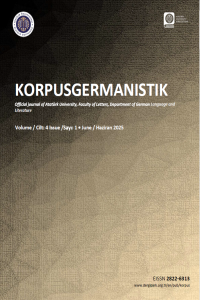Öz
Bu çalışmada Almanca ve Türkçenin biçimbirimsel-sözdizimsel yapıları karşılaştırmalı bir analiz çerçevesinde incelenmektedir. Çalışmada, tümce yapısı, zaman yapıları, edilgen yapılar, olumsuzlama ve yan tümceciklerin formülasyonu gibi merkezi dil bilgisi kategorilerine odaklanılmıştır. Her iki dilin tümce yapısı bakımından temel benzerlikleri olmasına rağmen, fiilin konumu ve çekimi, yardımcı fiillerin kullanımı ve dilbilgisi işaretlemesi türünde derin farklılıklar olduğu tespit edilmiştir. Almanca bükümlü bir dil olarak çeşitli sentetik biçimlere ve yardımcı yapılara dayanırken, Türkçe güçlü ek tabanlı yapıları olan sondan eklemeli bir dil olarak nitelendirilir. Bu farklılıklar özellikle zamanların oluşumunda, edilgen yapıda ve soru tümcelerindeki kelime diziminde belirginlik göstermektedir. Analiz, bazı yapısal paralelliklere rağmen her iki dilin dilbilgisi sistemlerinin farklı ilkelere dayandığını göstermeyi amaçlamaktadır.
Anahtar Kelimeler
Türkçe Tümce Ögeleri Almanca Tümce Ögeleri Temel İfade Tümceleri Soru Tümceleri Emir Tümceleri Tarz Eylem Tümceleri.
Kaynakça
- Buscha, J., u.a. (1993). Deutsche grammatik. Langenscheidt.
- Bußmann, H. (2008). Lexikon der sprachwissenschaft. Stuttgart: Alfred Kröner Verlag.
- Büyüktopçu, M. B. (2022). Konjugation im deutschen und im türkischen. Erzurum: Fenomen Yayıncılık.
- İmer, K., Kocaman, A.& Özsoy, A. S. (2011). Dilbilim sözlüğü. İstanbul: Boğaziçi Üniversitesi Yayınevi.
- Gross, H. (1998). Einführung in die germanistische linguistik. München: IUDICIUM Verlag GmbH.
- Pittner, K & Berman J. (2013). Deutsche syntax. Tübingen: Narr Verlag.
- Wahrig-Burfeind, R. (2008). Wahrig deutsches wörterbuch. München: Bertelsmann Lexikon Verlag.
- Zengin, D. (2008). Almanca dil hapı, Ankara: Kurmay Yayınları.
- Zengin, D. (2012). Her yönüyle modern almanca, Ankara: Kurmay Yayınları.
- https://deutschlernendlv.wordpress.com/9vp-vg/verben-perfekt/, Zugriffsdatum: 22.02.2023 um 00.11.
- https://grammatik-rechtschreibung.de/g_wortsatz.htm, Zugriffsdatum: 21.02.2023 um 22.45.
- https://www.beste-tipps-zum-deutsch-lernen.com/perfekt/, Zugriffsdatum: 22.02.2023 um 00.13.
- https://www.duden.de/rechtschreibung/Satz#bedeutungen, Zugriffsdatum: 15.04.2023 um 13.50.
- https://www.sofatutor.com/deutsch/videos/satzglieder-ueberblick-2, Zugriffsdatum: 15.04.2023 um 14.05.
- https://www.studienkreis.de/deutsch/zeitform-plusquamperfekt/, Zugriffsdatum: 17.11.2021 um 09.59.
Öz
Die vorliegende Arbeit untersucht im Rahmen einer kontrastiven Analyse die morpho-syntaktischen Strukturen des Deutschen und des Türkischen. Im Fokus stehen zentrale grammatische Kategorien wie Satzstruktur, Tempusbildung, Passivkonstruktionen, Negation sowie die Formulierung von Frage- und Nebensätzen. Dabei zeigt sich, dass beide Sprachen zwar grundlegende Gemeinsamkeiten hinsichtlich der Satzgliederung aufweisen, jedoch tiefgreifende Unterschiede in der Stellung und Flexion des Verbs, im Gebrauch von Hilfsverben sowie in der Art der grammatischen Markierung bestehen. Während das Deutsche als flektierende Sprache auf eine Vielzahl synthetischer Formen und Hilfskonstruktionen zurückgreift, charakterisiert sich das Türkische als agglutinierende Sprache mit stark suffixbasierten Strukturen. Besonders deutlich werden diese Divergenzen bei der Tempusbildung, der Passivform sowie der Wortstellung in Fragesätzen. Die Analyse verdeutlicht, dass trotz einzelner struktureller Parallelen die grammatischen Systeme beider Sprachen divergente Prinzipien verfolgen.
Anahtar Kelimeler
Türkische Satzglieder Deutsche Satzglieder Aussagesätze Fragesätze Imperativ Modalsätze.
Kaynakça
- Buscha, J., u.a. (1993). Deutsche grammatik. Langenscheidt.
- Bußmann, H. (2008). Lexikon der sprachwissenschaft. Stuttgart: Alfred Kröner Verlag.
- Büyüktopçu, M. B. (2022). Konjugation im deutschen und im türkischen. Erzurum: Fenomen Yayıncılık.
- İmer, K., Kocaman, A.& Özsoy, A. S. (2011). Dilbilim sözlüğü. İstanbul: Boğaziçi Üniversitesi Yayınevi.
- Gross, H. (1998). Einführung in die germanistische linguistik. München: IUDICIUM Verlag GmbH.
- Pittner, K & Berman J. (2013). Deutsche syntax. Tübingen: Narr Verlag.
- Wahrig-Burfeind, R. (2008). Wahrig deutsches wörterbuch. München: Bertelsmann Lexikon Verlag.
- Zengin, D. (2008). Almanca dil hapı, Ankara: Kurmay Yayınları.
- Zengin, D. (2012). Her yönüyle modern almanca, Ankara: Kurmay Yayınları.
- https://deutschlernendlv.wordpress.com/9vp-vg/verben-perfekt/, Zugriffsdatum: 22.02.2023 um 00.11.
- https://grammatik-rechtschreibung.de/g_wortsatz.htm, Zugriffsdatum: 21.02.2023 um 22.45.
- https://www.beste-tipps-zum-deutsch-lernen.com/perfekt/, Zugriffsdatum: 22.02.2023 um 00.13.
- https://www.duden.de/rechtschreibung/Satz#bedeutungen, Zugriffsdatum: 15.04.2023 um 13.50.
- https://www.sofatutor.com/deutsch/videos/satzglieder-ueberblick-2, Zugriffsdatum: 15.04.2023 um 14.05.
- https://www.studienkreis.de/deutsch/zeitform-plusquamperfekt/, Zugriffsdatum: 17.11.2021 um 09.59.
Öz
This paper examines the morpho-syntactic structures of German and Turkish within the framework of a contrastive analysis. The focus is on central grammatical categories such as sentence structure, tense formation, passive constructions, negation, and the formulation of interrogative and subordinate clauses. It shows that while both languages share fundamental similarities in sentence structure, there are profound differences in the position and inflection of verbs, the use of auxiliary verbs, and the type of grammatical marking. While German, as an inflectional language, relies on a variety of synthetic forms and auxiliary constructions, Turkish is characterized as an agglutinative language with strongly suffix-based structures. These divergences are particularly evident in tense formation, the passive form, and word order in interrogative sentences. The analysis illustrates that, despite individual structural parallels, the grammatical systems of both languages follow divergent principles.
Anahtar Kelimeler
Turkish sentence structures German sentence structures declarative sentences interrogative sentences imperative modal sentences.
Kaynakça
- Buscha, J., u.a. (1993). Deutsche grammatik. Langenscheidt.
- Bußmann, H. (2008). Lexikon der sprachwissenschaft. Stuttgart: Alfred Kröner Verlag.
- Büyüktopçu, M. B. (2022). Konjugation im deutschen und im türkischen. Erzurum: Fenomen Yayıncılık.
- İmer, K., Kocaman, A.& Özsoy, A. S. (2011). Dilbilim sözlüğü. İstanbul: Boğaziçi Üniversitesi Yayınevi.
- Gross, H. (1998). Einführung in die germanistische linguistik. München: IUDICIUM Verlag GmbH.
- Pittner, K & Berman J. (2013). Deutsche syntax. Tübingen: Narr Verlag.
- Wahrig-Burfeind, R. (2008). Wahrig deutsches wörterbuch. München: Bertelsmann Lexikon Verlag.
- Zengin, D. (2008). Almanca dil hapı, Ankara: Kurmay Yayınları.
- Zengin, D. (2012). Her yönüyle modern almanca, Ankara: Kurmay Yayınları.
- https://deutschlernendlv.wordpress.com/9vp-vg/verben-perfekt/, Zugriffsdatum: 22.02.2023 um 00.11.
- https://grammatik-rechtschreibung.de/g_wortsatz.htm, Zugriffsdatum: 21.02.2023 um 22.45.
- https://www.beste-tipps-zum-deutsch-lernen.com/perfekt/, Zugriffsdatum: 22.02.2023 um 00.13.
- https://www.duden.de/rechtschreibung/Satz#bedeutungen, Zugriffsdatum: 15.04.2023 um 13.50.
- https://www.sofatutor.com/deutsch/videos/satzglieder-ueberblick-2, Zugriffsdatum: 15.04.2023 um 14.05.
- https://www.studienkreis.de/deutsch/zeitform-plusquamperfekt/, Zugriffsdatum: 17.11.2021 um 09.59.
Ayrıntılar
| Birincil Dil | Almanca |
|---|---|
| Konular | Alman Dili, Edebiyatı ve Kültürü |
| Bölüm | Araştırma Makaleleri |
| Yazarlar | |
| Yayımlanma Tarihi | 15 Haziran 2025 |
| Gönderilme Tarihi | 29 Nisan 2025 |
| Kabul Tarihi | 2 Haziran 2025 |
| Yayımlandığı Sayı | Yıl 2025 Cilt: 4 Sayı: 1 |
Kaynak Göster
Content of this journal is licensed under a Creative Commons Attribution-NonCommercial (CC BY-NC) 4.0 International License


